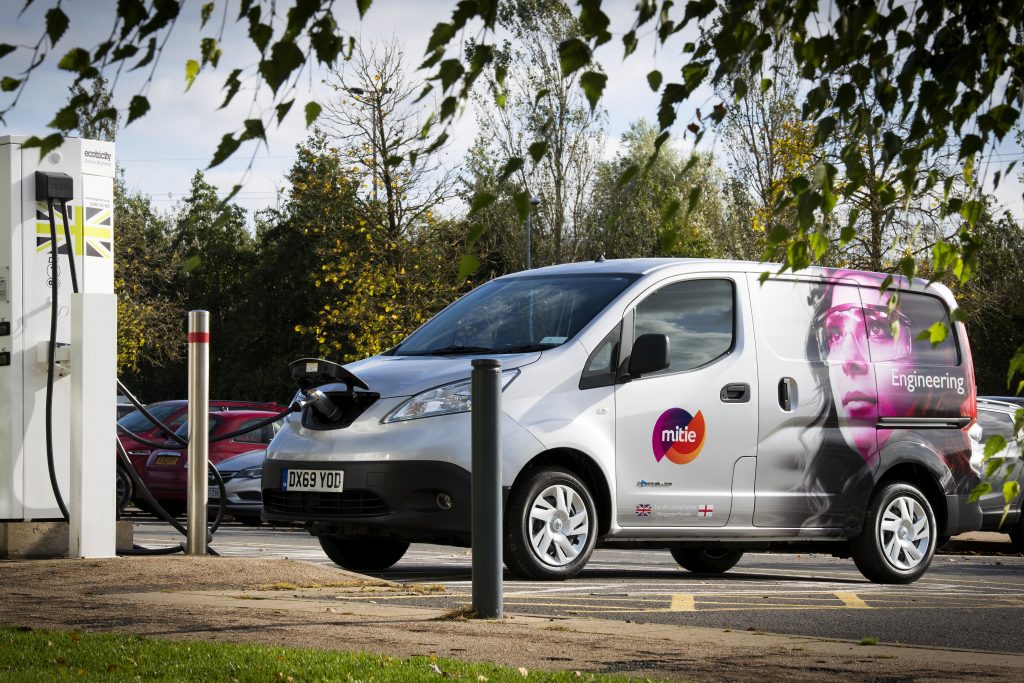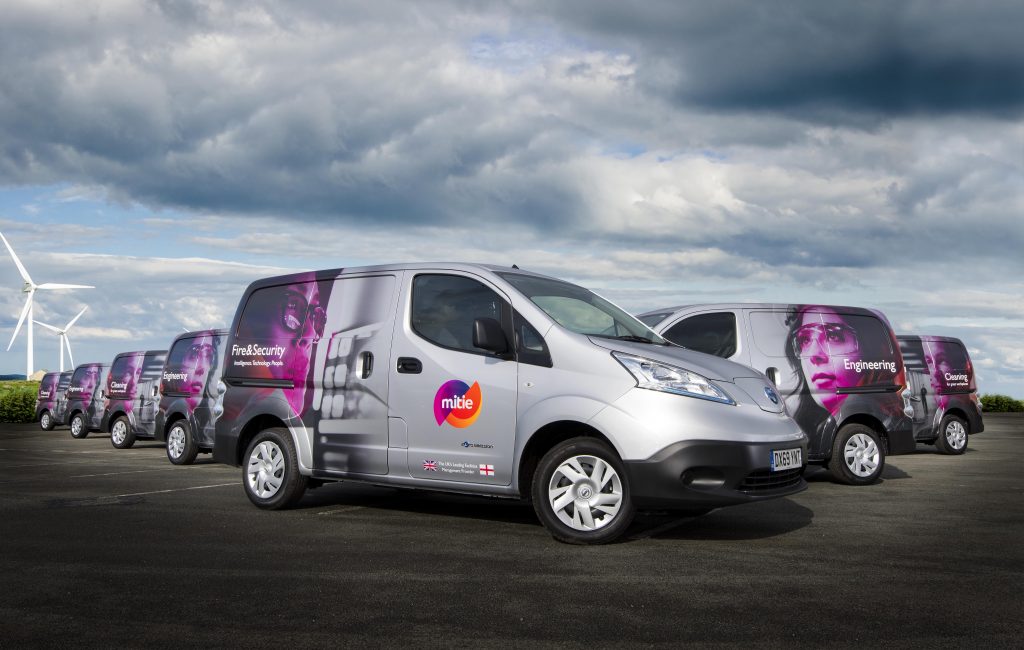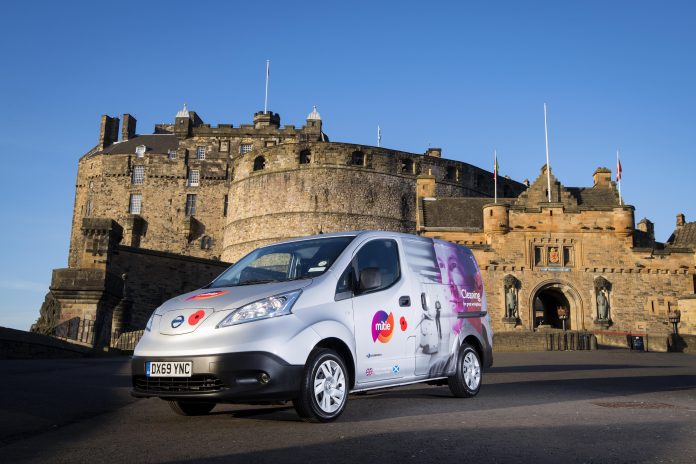Interview with Simon King – Fleet and Procurement Director, Mitie
From Fleet Manager Magazine – Issue 5(2019)
Mitie is at the forefront of EV adoption and this year are continuing to meet their objective of switching 20% of its small van and car fleet to electric by 2020 and 100% Electric by 2030. Much has been achieved so far, as demonstrated by the widely reported delivery of two electric vans to Edinburgh, the 100th and 101st EVs, the others being cars deployed at other contracts throughout the UK. By doing so, Mitie has begun the journey to have the UK’s largest electric fleet and will take a market-leading position.
The reality of how this will be achieved has thrown up many challenges for Mite’s Fleet and Procurement Director, Simon King, and we are grateful to him for sharing his findings.
In many organisations there is sometimes a disconnect between the procurement and fleet departments, often based around cost versus practicality. Simon’s background is firmly routed in procurement and he combines this extensive experience with other stakeholders to achieve outcomes that are operationally sound and deliver total value for Mitie as a business and ultimately also for its customers.

Simon has therefore developed a core procurement strategy that is not just based on cost but also encompasses specification, innovation, addresses environmental concerns and meets quality and safety targets. He also values working closely with trusted partners, enabling the business to be at the forefront of new ideas and new ways of working as they develop.
Q: With 93% of Mitie’s carbon footprint being attributed to its fleet, we understand that your first objective when you joined Mitie in 2018 was to evaluate the vehicle strategy, and it was during these early days of evaluation that it was clear that there was scope to switch Mitie’s car and small van fleet over to electric vehicles. What were the main factors that influenced your decision to commit to such an ambitious project of fleet electrification and which stakeholders were involved?
Our fleet is responsible for 93% of our business’ carbon footprint, so was the natural place for us to start in the fight against climate change. We started to explore transitioning our fleet to electric in 2018, and for us the decision was easy. As a business, social value is very important to us and we’re constantly trying to find ways we can help make the world a better place – whether that be environmentally or socially.
The environmental case for switching to EVs is clear, and with their lower running and maintenance costs the financials make sense for our business too. For us it was a no brainer. It can often be the case that it’s difficult to persuade senior figures to approve sustainability measures, but our Chief Executive understood the benefits immediately. Once we had him on board, we were able to go full steam ahead and publicly commit to switching 20% of our car and small van fleet to electric by 2020 – 717 vehicles. We chose this as
our initial target, following our comprehensive fleet review, which saw us move many of our large vans to smaller models, as we calculated that we could move 20% of our cars and small vans to electric. With more than 100 electric vehicles already on the road and 400 more on order, due for delivery in the first half of next year, we’re well on track to meet
this commitment.
Q: For most organisations the main barrier to the adoption of electric vehicles is the lack of infrastructure. We understand that you will have over 700 electric vehicles within your fleet by the end of 2020, and that you have already installed charge points at driver’s homes, at Mitie offices and on your customers sites. What have been the main problems that you have faced during the installation of this infrastructure? Could you share any solutions that you have identified, such as gaining landlord approval for charging installation?
Early on, the Mitie Fleet Team identified that access to adequate charging infrastructure throughout the country – Mitie has employees working across the length and breadth of the British Isles – would be one of our biggest challenges and a potential roadblock for our plans.
As such, we’ve made charge point installation a key part of our rollout. We’re working with our partner, Pod Point, to install 800 charge points at our own offices, client sites and at the homes of our employees that receive an EV. However, we did underestimate the bureaucracy and paperwork involved in liaising with our landlords to achieve this. It’s taken us about a year to install 22 charge points across Mitie offices, longer than we would initially have anticipated. People often say approaching charge point installation and electric vehicle ordering is chicken and egg – but based on our experience that really isn’t the case. Both need to be undertaken in tandem to make sure that by the time your new EVs are delivered you have the infrastructure you need in place.
However, these 22 charge points alone have saved 1,700 kg of carbon since September 2019 – the equivalent of driving nearly 9,000 miles in a petrol or diesel car.
We’re already investing in the nation’s charging infrastructure, but we need suppliers, government and local authorities to do more, so we can be confident that all our drivers will have access to a rapid charge point where and when they need it. While the rapid charge point network is quite mature in major towns and cities, once you get to more rural areas rapid charge points are few and far between.
We also want to see a more consistent approach to charge point use across providers. The current system whereby drivers may need a dozen different accounts or apps downloaded to their smart phone simply to grab 30 minutes charge, just isn’t sustainable. Our diesel drivers use a fuel card which is accepted widely and the payment comes directly to Mitie. However, the EV equivalent has less than 10% coverage of the national network so in many cases, our fleet drivers have to pay for fuel out of their own pocket and reclaim the cost. This isn’t sustainable in the long term.
Looking to the future, we want to be able to extend the energy we buy for our business – all of which is renewable – to our fleet drivers’ home charge points. This means that not only will all the energy used to charge a Mitie vehicle at home or work be zero carbon, but also that our people aren’t out of pocket when charging their work car or van. The technology is in place to make this happen, we just need regulation to change.
Q:The current range of electric LCVs is limited but is expanding. Obviously the availability is not the same as for ICE LCVs and you stated that you have had to work more closely with OEMs rather than putting out competitive tenders for your vehicles. Can you expand on what issues you came across that were the most challenging. What are the issues with current vehicle availability and with having reliable forecasts on new vehicle launches?
Given the large number of electric cars and vans that we are looking to procure, the biggest issue we face is being able to secure the volume of vehicles we need to meet our ambitious targets in a relatively short time frame. As a business that is used to buying thousands of vehicles a year, we are finding supply a challenge.Looking to the longer term, in order to electrify our entire fleet by 2030, then we need to see real, viable alternatives to diesel models for our larger van fleet. At the minute, there’s nothing out there, meaning we have some 2,000 vehicles that can’t yet be switched to electric. If we’re going to see widespread uptake of EVs across British fleets, this is something that urgently needs to be addressed. We want to be part of the solution, so we’re very keen to work with manufacturers and would encourage them to come speak to us about future vehicle development and trialling.
Q: You have clearly identified how fleet electrification meets the business needs of Mitie Group in the way that you can switch certain vehicles over to electric with no added costs when compared to the diesel equivalent. Is this for the most part due to reduced maintenance and fuel costs off-setting higher rentals?
As a business, we have moved away from reviewing just the purchase cost, to considering the vehicle’s whole life cost when deciding which models to choose. With this approach, the business case for EVs is clear. Fuel costs are significantly lower, around 4p per mile compared to 12p for the equivalent diesel model. In Scotland, this can be even cheaper as many public charge points are free to use, meaning fuel costs are essentially zero. And with fewer moving parts, the service, maintenance and repair costs are much lower too.
With regards to cars, there’s also a significant financial benefit for our company car drivers, as electric vehicles drivers pay no Benefit-in-Kind tax. We’d like to see a similar financial incentive introduced for vans, so we can encourage more of our van drivers to make the switch to electric too.
Q: An increasing number of your clients will be operating in low emission zones or will have their own environmental policies. In business terms, how big an advantage does this fleet strategy give you when renewing or seeking new contracts?
Climate change is on everyone’s agenda, whether that be government, business or individual consumers. Switching to electric vehicles offers a significant opportunity for all of these stakeholders, including our clients, to play their part in cutting carbon emissions and helping to improve air quality. This is highlighted by the fact that many of our clients have expressed an interest in having one of our new electric vehicles delivered to their contract – with our clients at Edinburgh Castle and Fife College being two key examples.
However, we know we can’t achieve anything in isolation. We want as many businesses as possible, customers and non-customers alike, to join us on the electric revolution. That’s why we’re spending time sharing our knowledge and learnings with as many organisations as possible, so others can learn.
Q: You described the wide-reaching benefit of your fleet electrification programme as having a positive impact on “People, Planet and Pocket”. Do you feel, from your experience, that these benefits can be replicated in a significant section of industry, commerce and the Public Sector?
No matter the size of your fleet, switching to EVs is sure to have a positive impact on people, planet and pocket. With the effects of climate change on the rise, every little helps. I’d encourage all businesses to look into which of their vehicles they can move over to an electric model. However, I appreciate that for small- to medium-sized companies that may not have the expertise in-house to manage a roll-out, it can seem daunting. We’ve already procured a very large volume of electric vehicles and are happy to share our experiences with as many businesses as possible. We know many fleet managers are looking for advice and support on how to switch their fleet to EVs and are already seeing people ask for our consultancy services. So, if anyone needs some advice on how to start or would even like to discuss a formal partnership to help begin your EV journey, please get in touch with me!
Published in Fleet Manager Issue 5 (2019) – click here

Mitie launches Plan Zero with a commitment to reach zero carbon by 2025 in FM industry first




